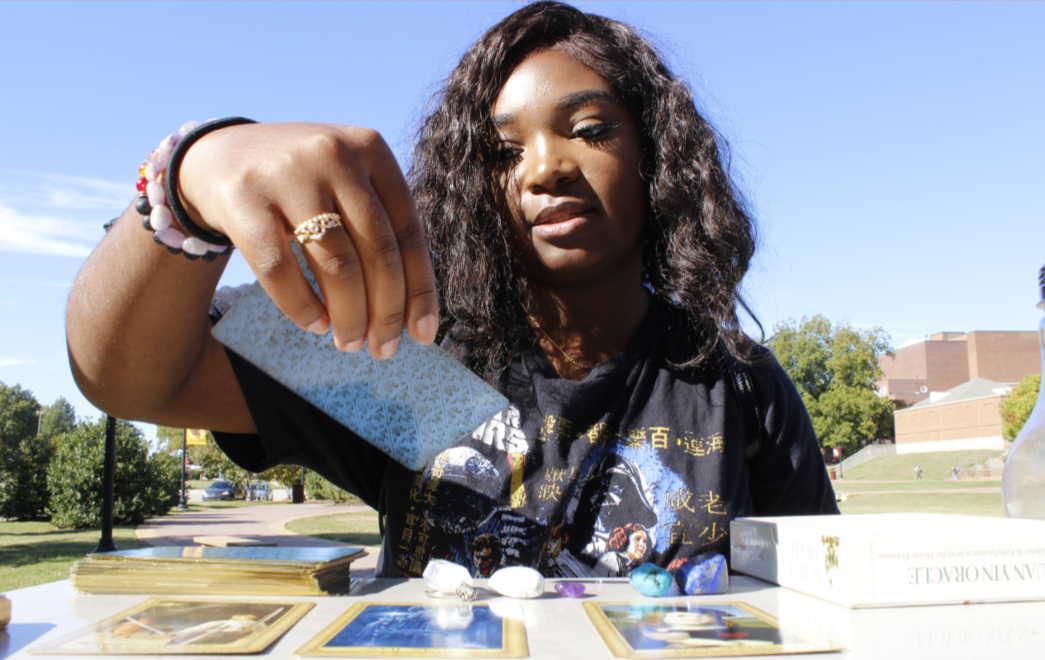In the centuries since the Salem Witch Trials, the word “witch” has been a death sentence, an insult, a storybook character, a Halloween icon, and has been reclaimed by a growing community of practitioners throughout the world. As Halloween approaches, many Winthrop students are preparing for the holiday in more spiritual ways than others. Winthrop students Erin Caffey, Jess Cook, Jade Jones, Nate Knight and Joey Morris are dispelling harmful myths, sharing the variety of ways in which people can practice witchcraft and exploring the positivity behind a practice often thought to be evil.
Junior social studies education major Erin Caffey does not personally call herself a witch, but identifies more strongly with the term “healer”. “I’m Scot-Irish, and my great-great-grandmother was an Irish healer. My great grandfather taught everything to my mom and my mom to me. I would assume it goes back even further than that.” Caffey said. “For me, my association with [witchcraft] is being in touch with other energies you might not be aware of unless you actively try to be.”
While many practice witchcraft as their religion, Caffey does not. “For me, it’s abilities that I was born with, things I’ve always been tapped into and encouraged to continue tapping into. I think most of us are probably born with similar abilities, but your rational mind as an adult tells you that those things are imaginary.” Caffey said.
Junior finance major Jade Jones also does not personally identify as a witch, although she works with tarot cards, crystals and astrology, sometimes involving elements of her Christian background. “I identify as spiritual,” Jones said. “I mostly practice tarot, I do some spells here and there, candle magic, I like working with crystals and stuff. Manifestation is the big one I like to do because to me, everything is in the power of the mind. So if you think bad things, you attract bad things. But if you think positive things, you attract positivity.”
Jones said she was drawn to the craft in part because of its emphasis on being good to others. “One misconception is that all witches are bad and evil and that if you do them wrong, they’ll curse you,” Jones said. “The big thing about Wicca is, ‘if it harms none, do what you will.’ And if you are looking to hex and curse people, it’ll come back on you like tenfold.”
Senior biology major Nate Knight practices an ‘eclectic’ form of witchcraft, drawing from Wiccan, Pagan, African Yoruba, Cuban Santeria and Voodoo beliefs. “I pull everything together and kind of shape it as my own. It’s fun because there’s no rules.” Knight said. “I embrace the term witch. I find it empowering in a way because it has such a negative connotation, so it’s so rebellious to say you are one.”
According to Knight, one phrase that is often used to insult and put witches down is “hocus pocus”.
“In the witch community ‘hocus pocus’ is a term we can use if we’re just talking about our craft, we call it ‘hocus pocus’ for fun, but we don’t want people to poke fun and call it that,” Knight said.
Knight said that in witchcraft, doing harm to others will come back threefold on the individual. “There is always some form of good, some form of bad karma. It just depends on which way you work it, because every time you do something wrong, there is a backlash. That’s common sense,” Knight said.
Freshman technical theatre major Jess Cook feels empowered by calling herself a witch. “What I practice is called Hellenic Polytheism, which is the belief in the Greek gods and the worship of the Greek gods. So a lot of my practice is based around them and the rituals around them, and drawing energy from the gods and using it towards my craft. A lot of my craft is energy based.” Cook said.
Junior history major Joey Morris also practices witchcraft as a religion, specifically what is known as hedge witchcraft.
“I interact with the astral plane, which is a plane of existence that I believe exists in a higher dimension than our reality exists in,” Morris said. “Being a hedge witch means that I work with this astral plane to harbor and sequester energy, and charge physical mundane objects such as rocks or any other natural substance. Natural substances are better for collecting energy and you can use the energy to gather and to manifest itself in a specific way.”
According to Morris, one common misconception is that witches practice “Hollywood” magic involving cauldrons and fantastical elements. “People think magic is very elemental and very physical based, so you can make objects float or create fire in your hands,” Morris says. “When you’re talking about magic, people think ‘oh you’re going to make this thing happen’. No, I’m going to influence this event to possibly occur out of a million other ways that what I am doing could have an effect on reality.”
While Caffey, Jones and Cook do not participate in most religious witchcraft rituals, Knight and Morris are preparing for Samhain (pronounced sah-wen), a Pagan holiday that takes place at the same as Halloween. Knight compared the holiday to the Mexican Day of the Dead, as Samhain involves honoring the dead and remembering lost loved ones. Morris said he often combines Samhain rituals with Halloween traditions.
“They’re two different cultural things but I celebrate both, so I’m going to use the essence of Halloween. In this ritual that I’m planning, I’m going to use a Jack-O-Lantern,” Morris said.
While there has been occasional pushback, Caffey, Jones, Cook, Morris and Knight said that their practices are usually embraced and encouraged by those around them, and less people view witchcraft as evil or frightening.
“A lot of people find it really cool. I haven’t had anyone so far really hate me because I’m a witch, people just think it’s really cool. So it always makes me happy when I get to share my experiences,” Cook said.
“Most of them want to know more,” Caffey said. “They ask what I can do, how can I do it, why do I do it, if they can learn, it’s normally pretty positive because I only share it with people who I think will view it as positive.”
Photo: Tate Walden/ The Johnsonian




